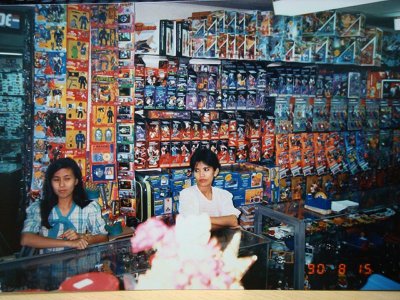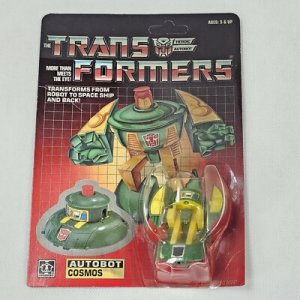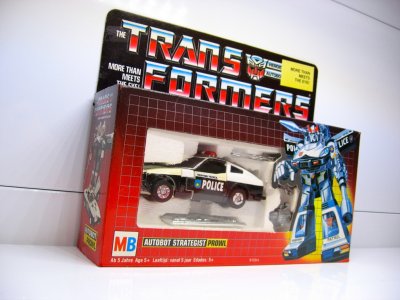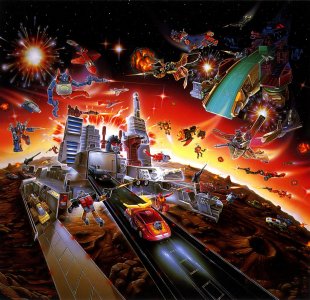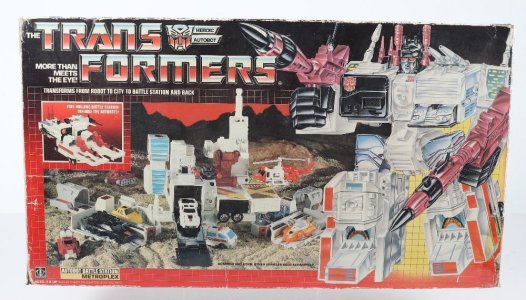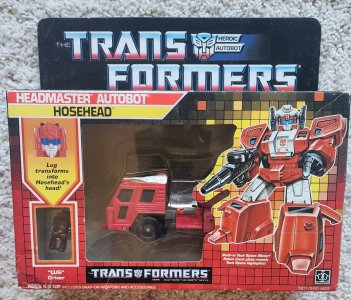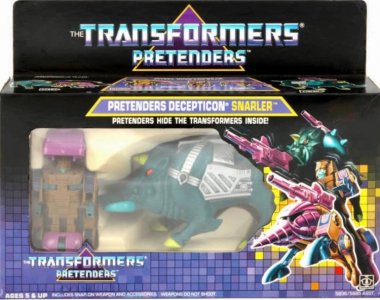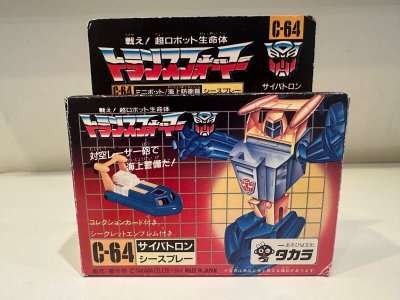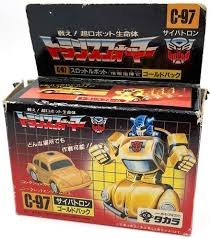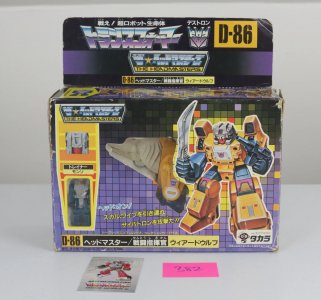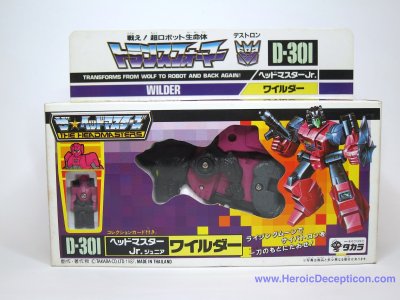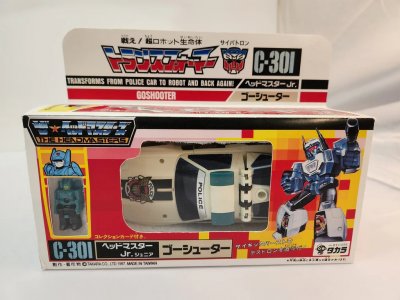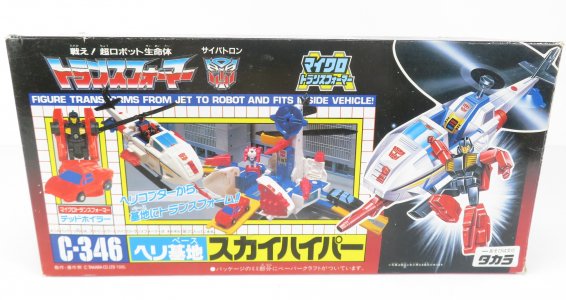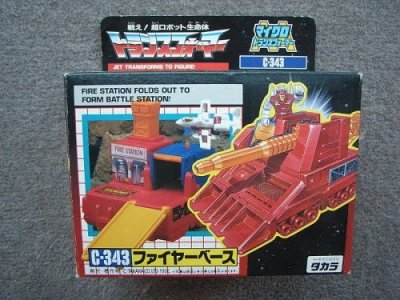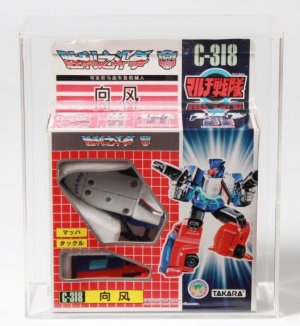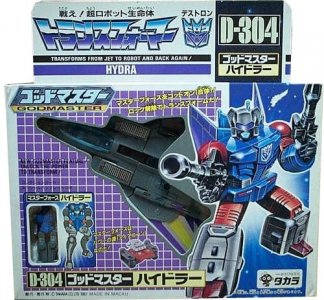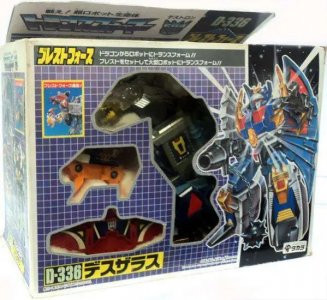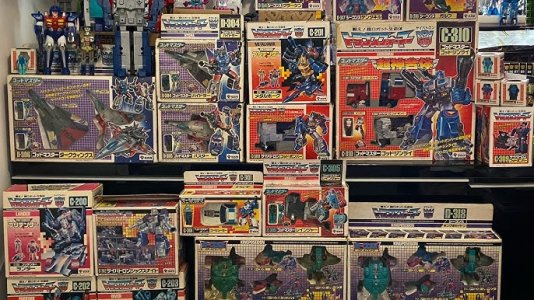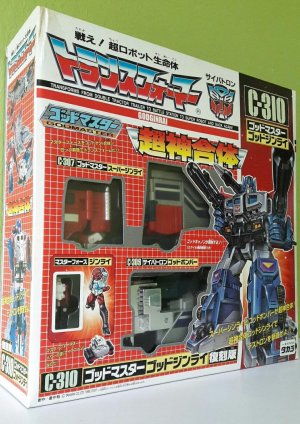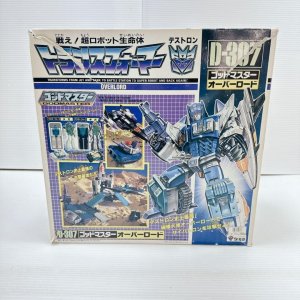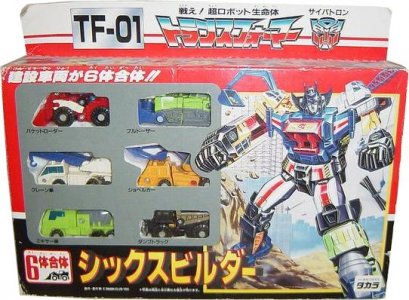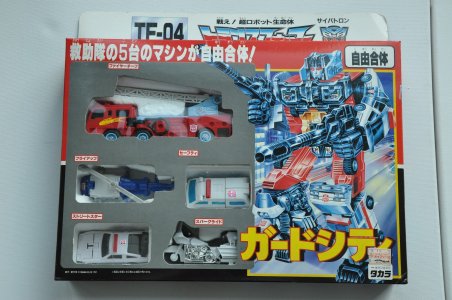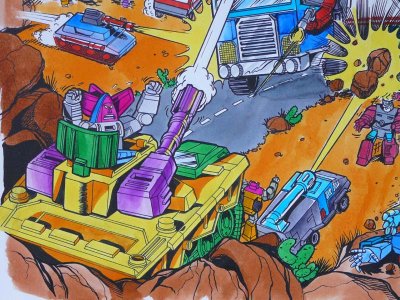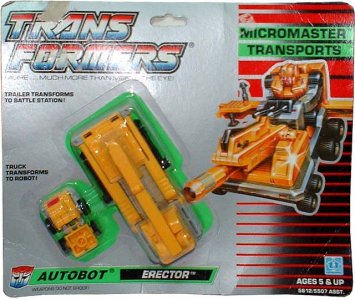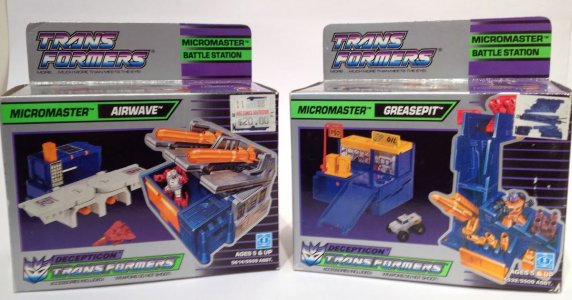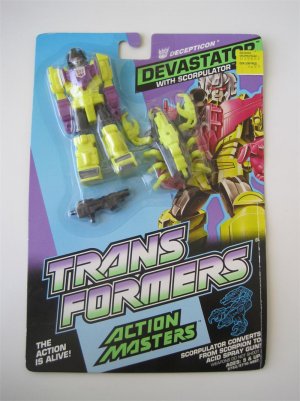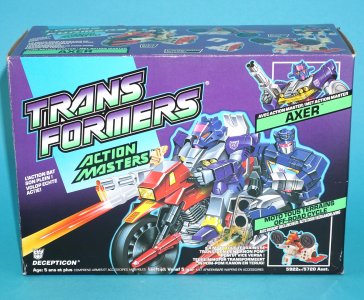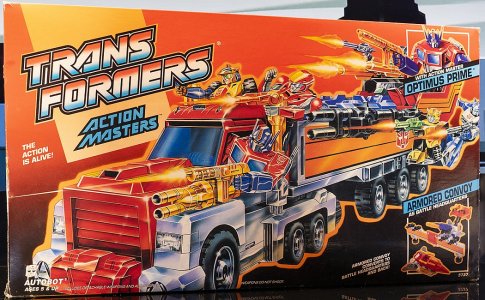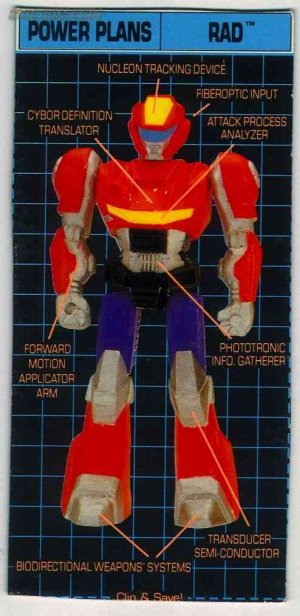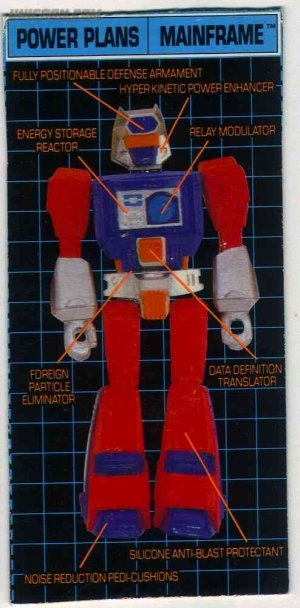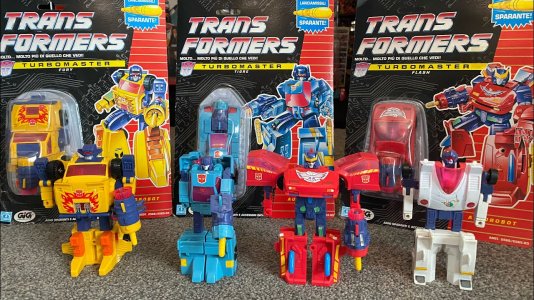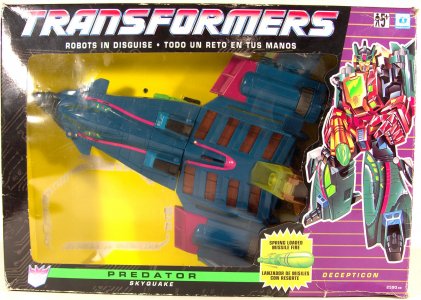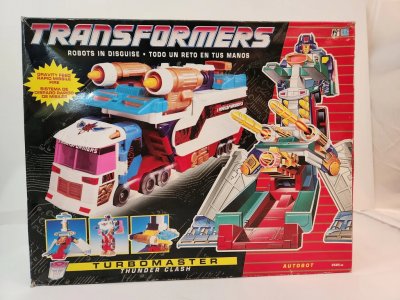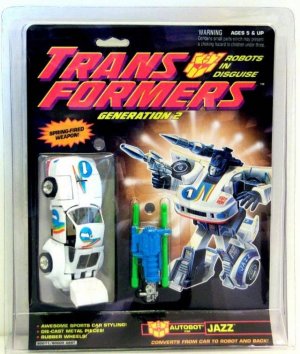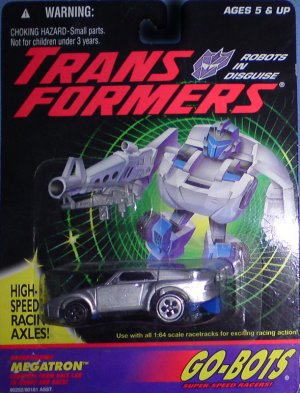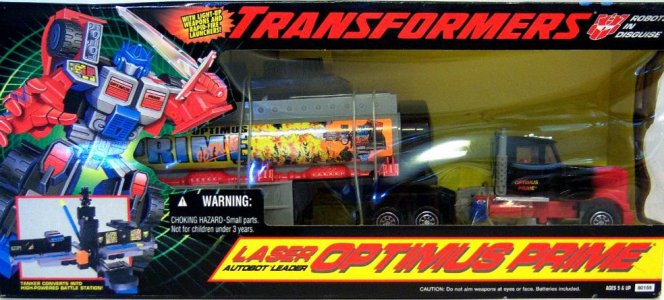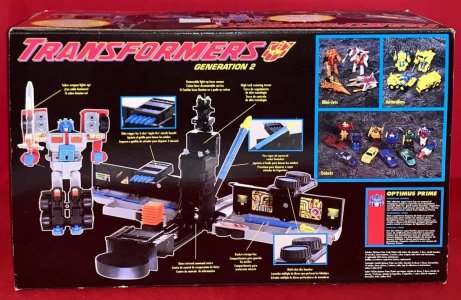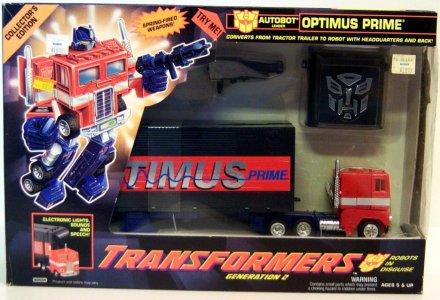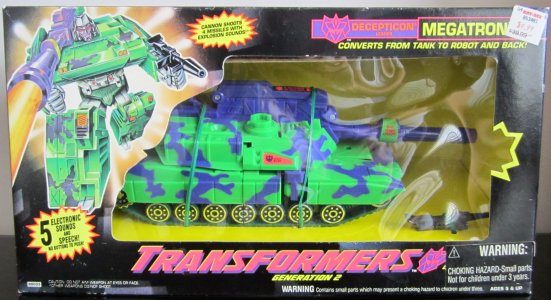This brand is more than forty years old, and that history has come with an undeniable amount of refreshing, reinventing, and rebooting. That also means it's been in stores, both physical and virtual, for all that time, and many of us (certainly the older element) have indelible memories of the first impression these toys make on us in person: as packaged items on store shelves.
This is a long mostly US-line-centric ramble about packaging, assisted by the wiki, and it'll be constrained by my own limited familiarity with and exposure to a lot of this (especially from further back), owing in turn to my geographic placement and economic situation at that point in my life (and later, uh, laziness I guess). All these pictures are stolen from various places online, and are just here to facilitate discussion and break up walls of rambling.
I invite you to put up with it, or (more likely) scroll past it, and tell me YOUR thoughts on Transformers packaging across the decades. I just think it's neat.
The 1980s
The retroactively-named Generation 1 gave us the classic, iconic grid-based packaging, in box and blister/card form. Toys ("Deluxe" and up) tended to be packed in altmode (nestled in styrofoam originally, iirc), with striking packaging design that faded from black into the white grid on red/purple (with a soft spotlight, later pixelated into the grid, behind the character art).
The juxtaposition of altmode toy and robot mode box art made it clear what being one of "The Transformers" meant, and the simple gimmick of "this is two toys in one" was illustrated neatly by a simple step-by-step photograph demo on the top of the box, and a callout that attested that this toy "transforms (later converts) from x to robot and back!". This was a great way to sell the toys, as in thos well-before-internet-days I remember a BIG hook for me was figuring out how the toys did what they did. How does this MASK vehicle turn into this MASK battle mode? Where do Swoop's robot legs go in dino mode? This was complemented by carded figures having instructions on the back of the card. Boxed figures had these paywalled, heh.
The box art was similarly gorgeous painted depictions of the toy in poses it almost certainly could never achieve, but with details and proportions that were fairly accurate to the design nonetheless. The murals on the back are also memorable, and lavish in the early years. I'm thrilled that we finally got a book archiving these years', for the most part, and wish we would get more comprehensive coverage for the other eras (the Visual History book is nice, but gimme all of it).
Along with the box art, it's worth noting the other key anchor of the packaging of this era: the panel featuring the character's Bio and Tech Specs. Bless you, Bob Budiansky, you took a toyline that could have coasted solely on the cool factor of its vehicles and box art for a year or two, and made nerds like me interested in finding out how cool they were "in person", as characters. Right down to having a motto or character quote that won me over faster, and more fully, than the also-cool trivia about what sci-fi weapon this dude had. This UFO guy is sad when he's away from his pals for too long. This fire truck is an adrenaline junkie. This cool-looking car is vain about being a cool-looking car. These little bits of personality went a long way, even if your sole exposure to the brand was the toys.
This was definitely an era when toys were surer sellers and harder to knock off their pedestal, and companies were generally willing to spend on production and packaging for even bigger-ticket items. I wasn't of age to be going from store to store in early G1, but I can't put into words the sheer wonder I felt upon seeing (I think) a beat-up packaged Sky Lynx (?) in a store that really had no business still having expensive toys from years ago but somehow did. (Sky Lynx would doubtless see this as fitting.)
I don't know if I ever saw a Metroplex at the time; maybe not. I probably would've fainted. Later on, seeing other big bois in local specialty stores evoked the same kind of childlike glee at seeing that packaging style blown up to such sizeable proportions. And decades later, getting the Encore Fortress Maximus in fittingly retro-feel packaging was quite the experience.
This would get streamlined and stylized as the years went by, with the color gradient in the main logo being tweaked for easier readability and things like a big triangle behind the letters being added (for the Pretenders era, which actually had "Pretenders" under "The Transformers" -- something I only remembered fully upon reviewing the wiki). It's a simple but effective grounding device; I have no art or design expertise with which to interpret this, but I like it. It's very distinct from the text orientation up to this point, which had tended to be left-aligned (to complement the box art on the lower right), and maintains the familiar packaging look while nudging it in its own direction. This works in tandem with the subtle change to the colors and design: the black half goes further, and the grid is now made up of pixelated mosaic tiles of color rather than overlaid onto a gradient. This stylizing of the sunburst behind the characters started to some degree around the time of the Headmasters packaging, which itself has some unique elements highlighting the Headmaster partner.
The 1980s/90s: Japan
Are you even still reading? Thanks and sorry. I also apologize in advance for this being probably the most glossed-over, underinformed part in an essay full of glossed-over, underinformed parts. All of this I really just found out when backtracking upon getting back into Transformers full-time in the early 2000s. You know, ~25 years ago ( /psychic damage)
Rediscovering Transformers was first a matter of finding out that Headmasters, Masterforce, and Victory were a thing, but only through text lists and descriptions in the early-internet days. And only later finding fansites (oh boy) that had pictures. It's hard to describe the feeling without seeming like I'm romanticizing it, but it technically is retracing history?
The earlier, still-in-sync-ish releases with the US lines had similar packaging, except with logos and really most text in Japanese (and, of course, the Japanese numbering label) for that extra weeb appeal. I do dig how almost all (?) of the toys came in a box, however small -- even stuff that would be carded in the US. I'd forgotten about this until seeing the Missing Link packaging for Bumblebee and Cliffjumper. Adorbs, fellow kids. And I can certainly see how this furthered the impression that Takara cared more about fans and whatnot, enough to give them premium packaging for everything unlike Cheap Has Blo.
Looking for these and seeing so many pictures in one go has really shown me that yes, Takara really put that company logo on things, hoo boy.
Once they had their own standalone toylines, however, they made their own packaging to go with them. Headmasters was initially more in line with the US boxes down to the pixel grid and highlights for the Headmaster, but with the show logo. They would then shift to very different-looking packaging and not look back from there. (The Headmasters closeups aren't in Transtector head mode, huh.) The Micromaster packaging was also kind of nice -- largely the same, but with a darker box base (the opposite of what they'd do later on).
Seeing pictures online, and then occasionally seeing these rarities in person in specialty stores, was quite the experience. I'd always assumed packaging worldwide was the same as the US, with translations where needed -- and when the US lines ended or paused, that they just kept using the same trade dress. Nooope.
As such, the discovery was a surprise. The largely-white/cream boxes seemed like such an aberration. Or a revelation. IDK. But it was definitely Not What You Got In America. The closest the Western releases had gotten was the silver Micromaster packaging. But here was a white/cream base, upon which would be the pixel fields and eventually a big white-on-faction-color grid.
For some reason, this doesn't come together as nicely for me as the darker packaging, partly because the white background doesn't really keep the eye reined in. (Later lines with white base packaging I'd come to like better, as we'll see when I get to the Unicron Trilogy era.) I THINK it might be that they felt like the bigger GI Joe vehicle boxes, where they didn't want to waste money on more ink and just printed on white cardboard. Maybe it's the thicker white-grid-on-solid-color feeling a little tablecloth-y. MAYBE it's the way the cutouts to show the toy are so close in against the toy -- actually more intricate work and probably costlier, but feeling like they were trying to clumsily display or hide the toy.
Or maybe it's that my first encounters with this look was probably with KOs that were copying these instead of US boxes (I vaguely recall a Skydive like this), intercepting Takara in forming that association? I don't really know. But as, uh, tacky as it sometimes feels (the boxes above are all right, but the more elements pile in, the more Graphic Design Is My Passion it feels) it's hard to deny the sheer impact of the bigger ticket items like God Ginrai or Overlord. Gorgeous box art and all, and packaging that really sold the impression of their size.
Shading into the 90s was Operation Combination, which did away with the grids and such entirely (except for on the back, somewhat cleverly echoing the scramble configurations). There were lots of solid color blocks instead, including a somewhat bland dark gray/silver sea surrounding the combiner team members. But there was nice, big box art that looked great. I especially love that they're set against backdrops, which we hadn't really gotten for main box art.
This, of course, is far from the end of the fun with Japanese Transformers packaging, as they'd continue to make their own twist on each era...
This is a long mostly US-line-centric ramble about packaging, assisted by the wiki, and it'll be constrained by my own limited familiarity with and exposure to a lot of this (especially from further back), owing in turn to my geographic placement and economic situation at that point in my life (and later, uh, laziness I guess). All these pictures are stolen from various places online, and are just here to facilitate discussion and break up walls of rambling.
I invite you to put up with it, or (more likely) scroll past it, and tell me YOUR thoughts on Transformers packaging across the decades. I just think it's neat.
The 1980s
The retroactively-named Generation 1 gave us the classic, iconic grid-based packaging, in box and blister/card form. Toys ("Deluxe" and up) tended to be packed in altmode (nestled in styrofoam originally, iirc), with striking packaging design that faded from black into the white grid on red/purple (with a soft spotlight, later pixelated into the grid, behind the character art).
The juxtaposition of altmode toy and robot mode box art made it clear what being one of "The Transformers" meant, and the simple gimmick of "this is two toys in one" was illustrated neatly by a simple step-by-step photograph demo on the top of the box, and a callout that attested that this toy "transforms (later converts) from x to robot and back!". This was a great way to sell the toys, as in thos well-before-internet-days I remember a BIG hook for me was figuring out how the toys did what they did. How does this MASK vehicle turn into this MASK battle mode? Where do Swoop's robot legs go in dino mode? This was complemented by carded figures having instructions on the back of the card. Boxed figures had these paywalled, heh.
The box art was similarly gorgeous painted depictions of the toy in poses it almost certainly could never achieve, but with details and proportions that were fairly accurate to the design nonetheless. The murals on the back are also memorable, and lavish in the early years. I'm thrilled that we finally got a book archiving these years', for the most part, and wish we would get more comprehensive coverage for the other eras (the Visual History book is nice, but gimme all of it).
Along with the box art, it's worth noting the other key anchor of the packaging of this era: the panel featuring the character's Bio and Tech Specs. Bless you, Bob Budiansky, you took a toyline that could have coasted solely on the cool factor of its vehicles and box art for a year or two, and made nerds like me interested in finding out how cool they were "in person", as characters. Right down to having a motto or character quote that won me over faster, and more fully, than the also-cool trivia about what sci-fi weapon this dude had. This UFO guy is sad when he's away from his pals for too long. This fire truck is an adrenaline junkie. This cool-looking car is vain about being a cool-looking car. These little bits of personality went a long way, even if your sole exposure to the brand was the toys.
This was definitely an era when toys were surer sellers and harder to knock off their pedestal, and companies were generally willing to spend on production and packaging for even bigger-ticket items. I wasn't of age to be going from store to store in early G1, but I can't put into words the sheer wonder I felt upon seeing (I think) a beat-up packaged Sky Lynx (?) in a store that really had no business still having expensive toys from years ago but somehow did. (Sky Lynx would doubtless see this as fitting.)
I don't know if I ever saw a Metroplex at the time; maybe not. I probably would've fainted. Later on, seeing other big bois in local specialty stores evoked the same kind of childlike glee at seeing that packaging style blown up to such sizeable proportions. And decades later, getting the Encore Fortress Maximus in fittingly retro-feel packaging was quite the experience.
This would get streamlined and stylized as the years went by, with the color gradient in the main logo being tweaked for easier readability and things like a big triangle behind the letters being added (for the Pretenders era, which actually had "Pretenders" under "The Transformers" -- something I only remembered fully upon reviewing the wiki). It's a simple but effective grounding device; I have no art or design expertise with which to interpret this, but I like it. It's very distinct from the text orientation up to this point, which had tended to be left-aligned (to complement the box art on the lower right), and maintains the familiar packaging look while nudging it in its own direction. This works in tandem with the subtle change to the colors and design: the black half goes further, and the grid is now made up of pixelated mosaic tiles of color rather than overlaid onto a gradient. This stylizing of the sunburst behind the characters started to some degree around the time of the Headmasters packaging, which itself has some unique elements highlighting the Headmaster partner.
The 1980s/90s: Japan
Are you even still reading? Thanks and sorry. I also apologize in advance for this being probably the most glossed-over, underinformed part in an essay full of glossed-over, underinformed parts. All of this I really just found out when backtracking upon getting back into Transformers full-time in the early 2000s. You know, ~25 years ago ( /psychic damage)
Rediscovering Transformers was first a matter of finding out that Headmasters, Masterforce, and Victory were a thing, but only through text lists and descriptions in the early-internet days. And only later finding fansites (oh boy) that had pictures. It's hard to describe the feeling without seeming like I'm romanticizing it, but it technically is retracing history?
The earlier, still-in-sync-ish releases with the US lines had similar packaging, except with logos and really most text in Japanese (and, of course, the Japanese numbering label) for that extra weeb appeal. I do dig how almost all (?) of the toys came in a box, however small -- even stuff that would be carded in the US. I'd forgotten about this until seeing the Missing Link packaging for Bumblebee and Cliffjumper. Adorbs, fellow kids. And I can certainly see how this furthered the impression that Takara cared more about fans and whatnot, enough to give them premium packaging for everything unlike Cheap Has Blo.
Looking for these and seeing so many pictures in one go has really shown me that yes, Takara really put that company logo on things, hoo boy.
Once they had their own standalone toylines, however, they made their own packaging to go with them. Headmasters was initially more in line with the US boxes down to the pixel grid and highlights for the Headmaster, but with the show logo. They would then shift to very different-looking packaging and not look back from there. (The Headmasters closeups aren't in Transtector head mode, huh.) The Micromaster packaging was also kind of nice -- largely the same, but with a darker box base (the opposite of what they'd do later on).
Seeing pictures online, and then occasionally seeing these rarities in person in specialty stores, was quite the experience. I'd always assumed packaging worldwide was the same as the US, with translations where needed -- and when the US lines ended or paused, that they just kept using the same trade dress. Nooope.
As such, the discovery was a surprise. The largely-white/cream boxes seemed like such an aberration. Or a revelation. IDK. But it was definitely Not What You Got In America. The closest the Western releases had gotten was the silver Micromaster packaging. But here was a white/cream base, upon which would be the pixel fields and eventually a big white-on-faction-color grid.
For some reason, this doesn't come together as nicely for me as the darker packaging, partly because the white background doesn't really keep the eye reined in. (Later lines with white base packaging I'd come to like better, as we'll see when I get to the Unicron Trilogy era.) I THINK it might be that they felt like the bigger GI Joe vehicle boxes, where they didn't want to waste money on more ink and just printed on white cardboard. Maybe it's the thicker white-grid-on-solid-color feeling a little tablecloth-y. MAYBE it's the way the cutouts to show the toy are so close in against the toy -- actually more intricate work and probably costlier, but feeling like they were trying to clumsily display or hide the toy.
Or maybe it's that my first encounters with this look was probably with KOs that were copying these instead of US boxes (I vaguely recall a Skydive like this), intercepting Takara in forming that association? I don't really know. But as, uh, tacky as it sometimes feels (the boxes above are all right, but the more elements pile in, the more Graphic Design Is My Passion it feels) it's hard to deny the sheer impact of the bigger ticket items like God Ginrai or Overlord. Gorgeous box art and all, and packaging that really sold the impression of their size.
Shading into the 90s was Operation Combination, which did away with the grids and such entirely (except for on the back, somewhat cleverly echoing the scramble configurations). There were lots of solid color blocks instead, including a somewhat bland dark gray/silver sea surrounding the combiner team members. But there was nice, big box art that looked great. I especially love that they're set against backdrops, which we hadn't really gotten for main box art.
This, of course, is far from the end of the fun with Japanese Transformers packaging, as they'd continue to make their own twist on each era...
Last edited:

